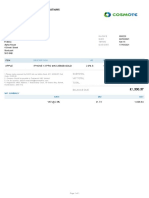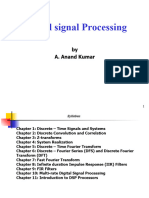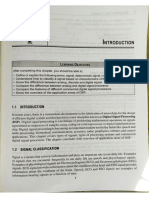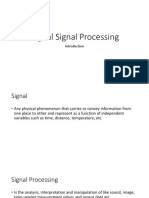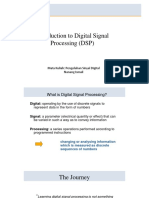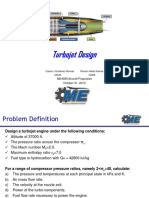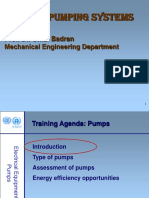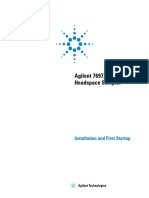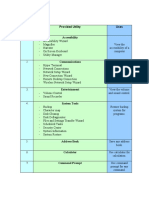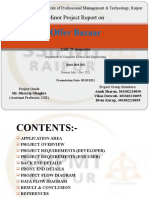Digital Signal Processing: Course Code: Credit Hours:3 Prerequisite:30107341
Uploaded by
محمد القدوميDigital Signal Processing: Course Code: Credit Hours:3 Prerequisite:30107341
Uploaded by
محمد القدوميDigital Signal Processing
Course Code : 30102545
Credit Hours :3
Prerequisite :30107341
Instructor Information
Name Anwar Alflayyeh
Office No. B17 F4
Tel (Ext)
E-mail [email protected]
Office Hours 11:00-12:00 STT
Class Times Building Day Start Time End Time Room No.
Online Sunday 10 11:00PM Online
Tuesday
Thursday
Course description Introduction to DSP. Discrete signals
and systems. Z-transform. Modeling and implementation of
discrete time systems. Time and frequency domain analysis of
signal processors. Design and analysis of finite impulse
response filters (FIR). Design and analysis of infinite impulse
response filters (IIR). Digital filter networks. Digital equalizers.
The DFT and FFT algorithms. DSP algorithms and applications
Course Title; Digital Signal Processing
Credit Hour(3-0)
Textbook: Textbook Title
Image of the textbook Cover
COURSE OBJECTIVES
The main objectives of the course are:
Introduce and discuss digital signal processing systems
Study of discrete time signals and systems
Manipulate discrete time signals and systems using transform methods
Develop the capabilities of students to perform signals and systems analysis using
computers
Analysis and design of digital IIR and FIR filters.
COURSE SYLLABUS
Week Course Topic
Week 1 Introduction to Digital Signal & Image Processing
Week 2 Analog to Digital & Digital to Analog Conversion
Week 3 Digital Signals
Week 4 Difference Equation & Diagrams
Week 5 Convolution & Correlation
Week 6 The z-Transforms & Stability
Week 7 Discrete Fourier Transform & Frequency Response
Week 8 Mid Term Exam
Week 9 Discrete Fourier Analysis & Signal Spectrum
Week 10 Finite Impulse Response Filter Design
Week 11 Infinite Impulse Response Filter Design
Week 12 Hardware and Software for Digital Signal Processors
Week 13 Adaptive Filters & Applications
Week 14 Multi-rate Signal Processing
Week 15 Fundamentals of Image Processing
Digital Signal Processing
week 1
Overview
• Introduction
• Signal, System, and Signal Processing
• Analog vs. Digital Signal Processing
• Advantages of Digital Signal Processing
• DSP Applications
• DSP Examples
Signal
• A signal is a physical quantity, or quality, which conveys
information
Example:
• voice of my friend is a signal which causes me to perform
certain actions or react in a particular way
• My friend's voice is called an excitation(input)
• My action or reaction is called a response (output)
9
System
• A system is an entity that manipulates one or more signals to
accomplish a function, thereby yielding new signals.
10
Typical Digital Signal Processing System
11
Signal Processing
Signal Processing
• The conversion from excitation to response is called signal
processing
• A typical reason for signal processing is to eliminate or reduce
an undesirable signal
• We convert the original signal into a form that is suitable for
further processing
• One fundamental representation of a signal is as a function of
at least one independent variable
12
Analog vs. Digital Signal Processing
• Most signals of practical interest are analog in nature
Examples: Voice, Video, RADAR signals, Transducer/Sensor output,
Biological signals etc
• So in order to utilize those benefits, we need to convert our analog
signals into digital
• This process is called A/D conversion
13
Advantages of Digital Signal Processing
• A digital programmable system allows flexibility in
reconfiguring the DSP operations simply by changing the
program. Reconfiguration of an analogue system usually
implies a redesign of hardware, testing and verification that it
operates properly.
• DSP provides better control of accuracy requirements.
• Digital signals are easily stored on storage media i.e. hard disk
14
Analog to Digital Conversion
Sample & Hold (Sampler)
• Analog signal is continuous in time and continuous in
amplitude.
• It means that it carries infinite information of time
and infinite information of amplitude.
• Analog (continuous-time) signal has some value
defined at every time instant, so it has infinite number
of sample points.
15
Advantages of Digital Signal Processing
• The DSP allows for the implementation of more
sophisticated
• signal processing algorithms.
• • In some cases, a digital implementation of the signal
• processing system is cheaper than its analogue
counterpart.
• • DSP consume relatively less power than analog
counterpart.
• • DSP processor can be reuse for many applications
16
continue
The DSP allows for the implementation of more sophisticated
signal processing algorithms.
• In some cases a digital implementation of the signal
processing system is cheaper than its analogue counterpart.
• DSP consume relatively less power than analog counterpart. The first essential
step in analog-to-digital (A/D) conversion is to sample an analog signal.
This step is performed by a sample and hold circuit, which samples at regular
intervals called sampling intervals.
Sampling can take samples at a fixed time interval.
The length of the sampling interval is the same as the sampling period, and the
reciprocal of the sampling period is the sampling frequency fs.
17
DSP Application
• The DSP allows for the implementation of more
sophisticated
• signal processing algorithms.
• • In some cases, a digital implementation of the signal
• processing system is cheaper than its analogue
counterpart.
• DSP consume relatively less power than analog
counter art.
18
DSP Applications
• Echo cancellation
• Antilock brakes
• Signal and image compression
• Noise reduction
• Companding
• High-definition television (HDTV)
• Digital audio
• Encryption
• Motor control
• Smart appliances
• Home security
• High speed modems 19
DSP Medical Application
• CT scans
• Magnetic resonance image (MRI) scans
• Diagnostic ultrasound imaging
• Electrocardiogram(ECG) analysis
• Electroencephalogram(EEG) analysis
• Medical image processing
• Cochlear implants
• Remote medical monitoring
• Speech synthesis
• Speech recognition
• Hearing aid 20
DSP Example
21
50/60 Hz Interference Cancellation in Electrocardiography
22
DSP Examples
23
DSP Example
24
DSP Examples
25
DSP Example
You might also like
- Cosmote Mobile Telecomm Sa Greece 2021 PDFNo ratings yetCosmote Mobile Telecomm Sa Greece 2021 PDF1 page
- Digital Signal Processing: BY T.Sravan Kumar ECENo ratings yetDigital Signal Processing: BY T.Sravan Kumar ECE19 pages
- Digital Signal Processing: (Course code-ECE 303100% (1)Digital Signal Processing: (Course code-ECE 30339 pages
- Digital Signal Processing Digital Signal Processing Design DesignNo ratings yetDigital Signal Processing Digital Signal Processing Design Design20 pages
- Advanced Digital Signal Processing Lecture 10% (1)Advanced Digital Signal Processing Lecture 142 pages
- The Typical Digital Signal Processing Block DiagramNo ratings yetThe Typical Digital Signal Processing Block Diagram6 pages
- Digital Signal Processing: Yogananda IsukapalliNo ratings yetDigital Signal Processing: Yogananda Isukapalli29 pages
- Digital Signal Processing and A To D ConversionNo ratings yetDigital Signal Processing and A To D Conversion21 pages
- Signals and Signal Processing: Prepared By: Prof. Iyad Jafar Instructor: Prof. Dia AbunnadiNo ratings yetSignals and Signal Processing: Prepared By: Prof. Iyad Jafar Instructor: Prof. Dia Abunnadi15 pages
- DSP Is Everywhere: Digital Signal ProcessingNo ratings yetDSP Is Everywhere: Digital Signal Processing20 pages
- Turbojet Design: ME4935 Aircraft Propulsion October 31, 2013No ratings yetTurbojet Design: ME4935 Aircraft Propulsion October 31, 201327 pages
- Experiment Three: Charging System: DynamoNo ratings yetExperiment Three: Charging System: Dynamo12 pages
- Pumps & Pumping Systems: Prof. Dr. Omar Badran Mechanical Engineering DepartmentNo ratings yetPumps & Pumping Systems: Prof. Dr. Omar Badran Mechanical Engineering Department39 pages
- Digital Signal Processing: Course Code: Credit Hours:3 Prerequisite:30107341No ratings yetDigital Signal Processing: Course Code: Credit Hours:3 Prerequisite:3010734148 pages
- Design of Hose Reel System: - Nozzle: P 200 Kpa 0.4 L/S100% (2)Design of Hose Reel System: - Nozzle: P 200 Kpa 0.4 L/S36 pages
- Digital Signal Processing: Course Code: Credit Hours:3 Prerequisite:30107341No ratings yetDigital Signal Processing: Course Code: Credit Hours:3 Prerequisite:3010734148 pages
- Digital Signal Processing: Course Code: Credit Hours:3 Prerequisite:30107341No ratings yetDigital Signal Processing: Course Code: Credit Hours:3 Prerequisite:3010734140 pages
- Digital Signal Processing: Course Code: Credit Hours:3 Prerequisite:30107341No ratings yetDigital Signal Processing: Course Code: Credit Hours:3 Prerequisite:3010734156 pages
- Sonam Kundan +91-98181-58183: Organizational ExperienceNo ratings yetSonam Kundan +91-98181-58183: Organizational Experience2 pages
- Agilent 7697A Headspace Sampler: Installation and First StartupNo ratings yetAgilent 7697A Headspace Sampler: Installation and First Startup74 pages
- Consolidated Orbit TroubleShooting Flow Charts - V1 - 0 - 0No ratings yetConsolidated Orbit TroubleShooting Flow Charts - V1 - 0 - 014 pages
- ZK-D3180 - User Manual - V1.0 - en - 20210830No ratings yetZK-D3180 - User Manual - V1.0 - en - 2021083048 pages
- Everything You Need To Memorise - Part 2, Core Pure Year 2 PDFNo ratings yetEverything You Need To Memorise - Part 2, Core Pure Year 2 PDF1 page
- Donald E. Kieso, Jerry J. Weygandt, Terry D. Warfield - Intermediate Accounting IFRS 4th Edition by Donald E. Kieso-Wiley (2020) - 1601-1608No ratings yetDonald E. Kieso, Jerry J. Weygandt, Terry D. Warfield - Intermediate Accounting IFRS 4th Edition by Donald E. Kieso-Wiley (2020) - 1601-16088 pages
- Ironton Angle Grinder Holder-Item# 61454No ratings yetIronton Angle Grinder Holder-Item# 6145418 pages
- ISTRAC24161997 Stage1 9372853933 6940002981No ratings yetISTRAC24161997 Stage1 9372853933 69400029814 pages
